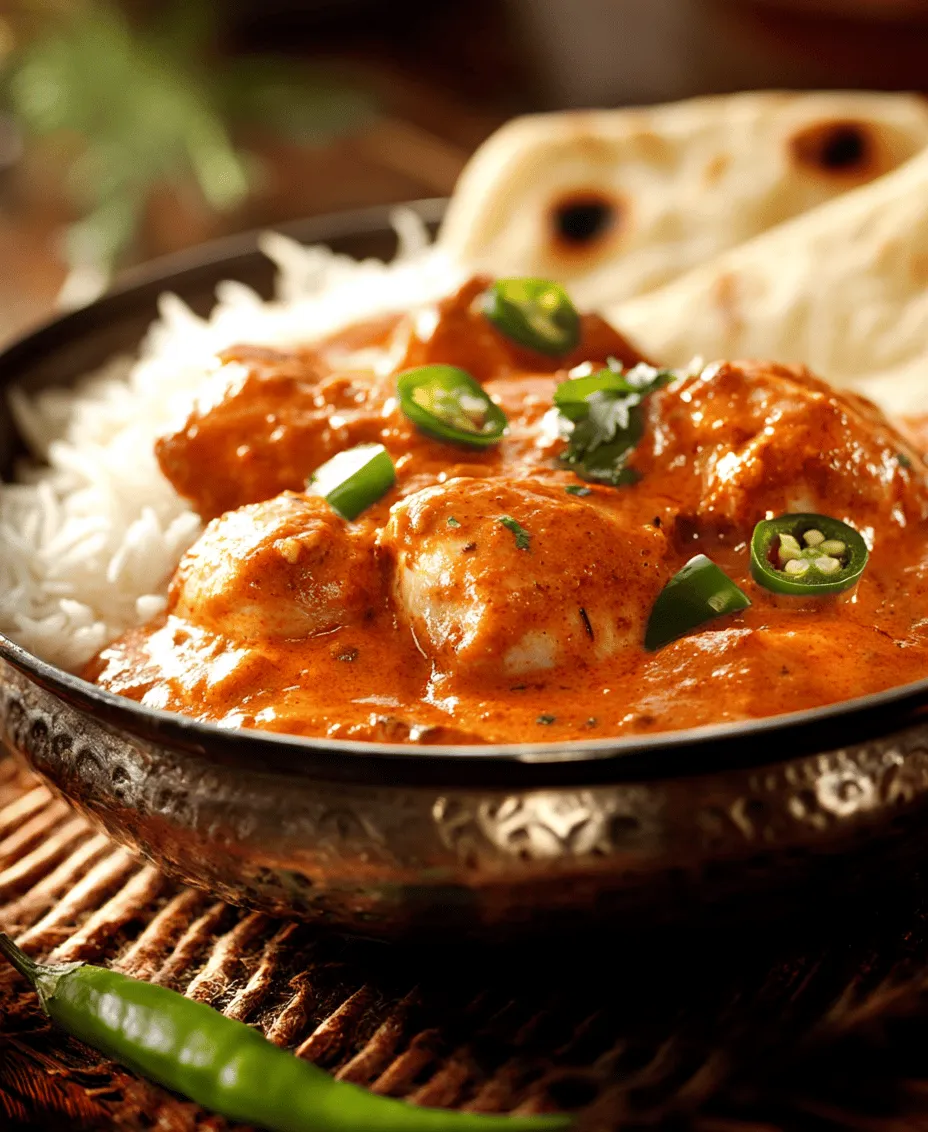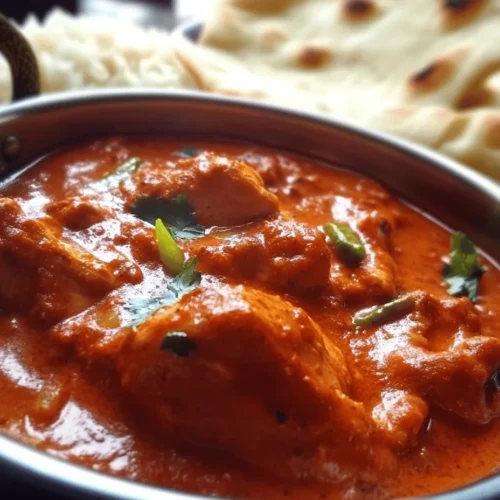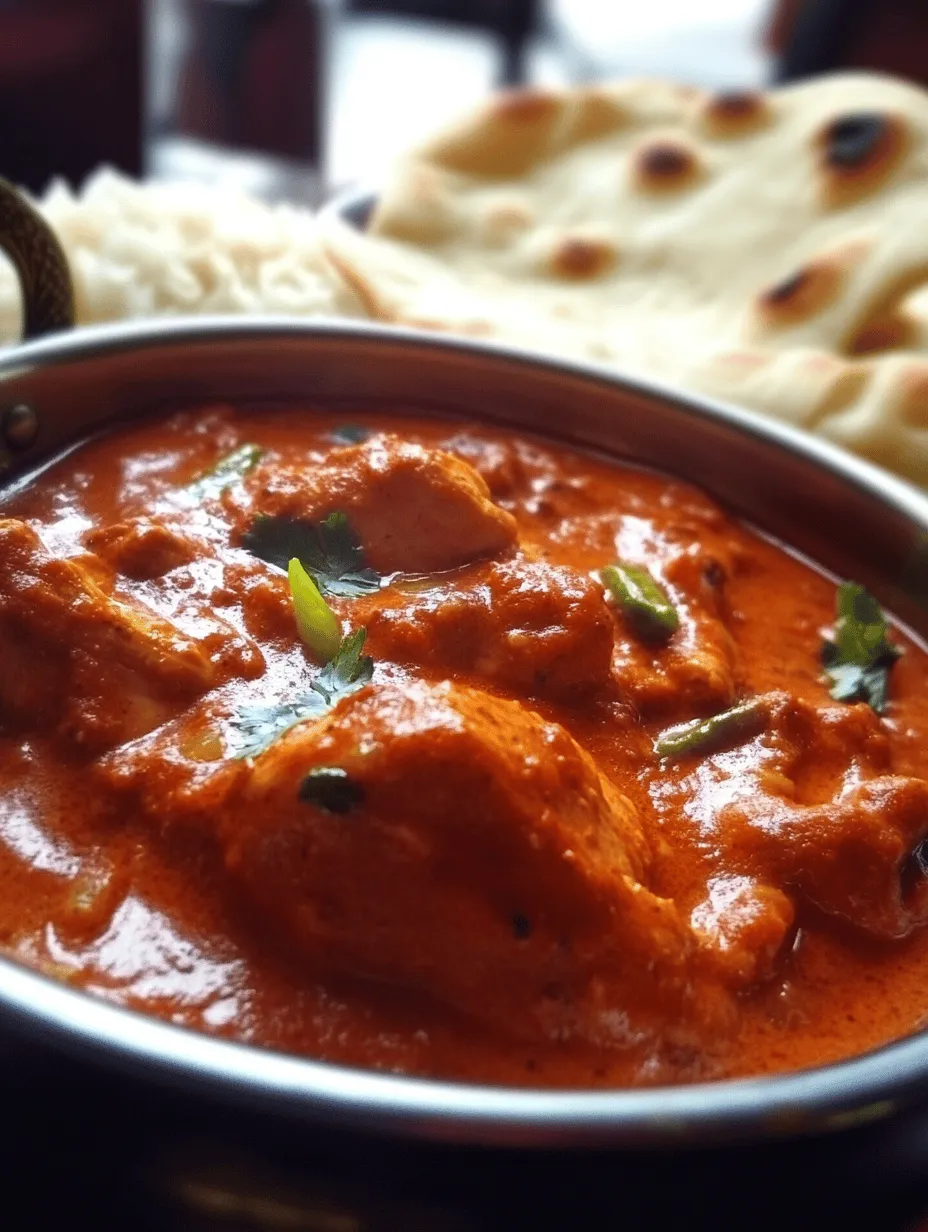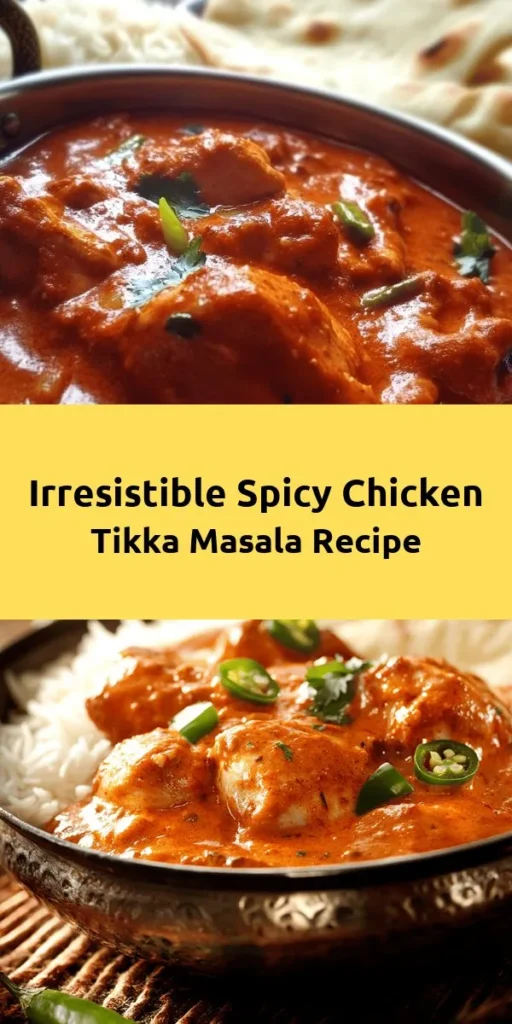Introduction
Spicy Chicken Tikka Masala stands as one of the most cherished dishes in Indian cuisine, celebrated not just for its vibrant flavors but also for its comforting qualities. This dish has garnered a global following, finding its way into homes and restaurants far beyond the borders of India. Its rich, aromatic sauce, tender chicken pieces, and the perfect blend of spices make it a delight, whether served with rice or warm naan bread. This article aims to provide a comprehensive recipe, cooking techniques, and insights into the cultural significance of Chicken Tikka Masala, allowing you to recreate this beloved dish in your own kitchen.
Understanding Chicken Tikka Masala
Origin and History of Chicken Tikka Masala
The origins of Chicken Tikka Masala are as rich and varied as its flavors. While it is widely regarded as a staple of Indian cuisine, its exact roots are a matter of culinary debate. Some food historians trace its origins to the Punjab region of India, where marinated chicken is grilled and served with a yogurt-based sauce. Others claim that the dish was popularized in the UK, where it was adapted by South Asian immigrants in the 1960s and 1970s.
Regardless of its true origin, Chicken Tikka Masala has become a symbol of the fusion between Indian and British culinary traditions. It represents the adaptability of Indian cuisine and showcases the ability to meld traditional flavors with contemporary tastes.
The Role of Chicken Marination in Enhancing Flavor and Tenderness
One of the critical elements in preparing Chicken Tikka Masala is the marination of the chicken. Marinating chicken not only infuses it with robust flavors but also tenderizes the meat, making it juicier and more succulent. The marinade typically consists of yogurt and an array of spices that penetrate the chicken, ensuring that each bite is bursting with flavor.
Yogurt is a key component of the marinade, as it contains enzymes that help break down protein, resulting in tender chicken. This process is essential for achieving the perfect texture, which complements the creamy sauce that characterizes Chicken Tikka Masala.
Significance of Spices in Indian Cooking
Spices are the heart and soul of Indian cuisine, and Chicken Tikka Masala is no exception. The careful selection and combination of spices transform simple ingredients into an extraordinary dish. Each spice plays a unique role, contributing its distinctive flavor profile to the overall dish. For instance, cumin adds a warm, earthy taste, while turmeric provides a vibrant color and subtle bitterness. The use of garam masala, a blend of various spices, enhances the complexity of the dish, making it truly memorable.
Key Ingredients for Spicy Chicken Tikka Masala
Overview of Primary Ingredients Used in the Recipe
To create an authentic Spicy Chicken Tikka Masala, you’ll need a selection of key ingredients that work harmoniously together. The primary components include chicken thighs, yogurt, a variety of spices, and fresh herbs. Each ingredient contributes to the overall flavor and authenticity of the dish.
Detailed Description of Chicken Thighs and Their Benefits for This Dish
While many recipes call for chicken breasts, chicken thighs are the preferred choice for Chicken Tikka Masala. Thighs are darker meat, which means they are naturally juicier and more flavorful than breasts. Their higher fat content ensures that they remain tender even after cooking, making them ideal for grilling and simmering in a sauce. Additionally, chicken thighs are often more economical, making them a practical option for home cooks.
The Importance of Yogurt in Marination
Yogurt serves a dual purpose in this recipe. First, it acts as a marinade, helping to tenderize the chicken while infusing it with flavor. The acidity in yogurt breaks down the proteins in the meat, resulting in a tender texture that is essential for a delicious Chicken Tikka Masala. Second, yogurt helps to balance the heat from the spices, creating a harmonious blend of flavors that are not overwhelming.
Explanation of Spices
To achieve the bold and complex flavors that Chicken Tikka Masala is known for, several spices are essential:
– Ground Cumin: This spice adds a warm, nutty flavor that is foundational in Indian cooking. It pairs well with other spices and enhances the overall depth of the dish.
– Ground Coriander: Known for its citrusy notes, ground coriander brightens the dish and complements the richness of the sauce.
– Turmeric Powder: Turmeric is celebrated for its vibrant yellow color and earthy flavor. It also adds health benefits, making it a staple in many Indian recipes.
– Garam Masala: A blend of spices that typically includes cinnamon, cardamom, and cloves, garam masala adds warmth and complexity to the dish, elevating it to new culinary heights.
– Chili Powder: This spice provides the necessary heat for Spicy Chicken Tikka Masala. Adjust the amount to suit your personal spice tolerance, allowing you to control the heat level of the dish.
Breakdown of Sauce Ingredients
The sauce in Chicken Tikka Masala is what truly makes the dish shine. It is typically rich and creamy, with a perfect balance of spices and aromatics.
– Role of Onions and Their Caramelization: Onions are a fundamental base for the sauce, contributing both sweetness and depth of flavor. Caramelizing the onions enhances their natural sugars, resulting in a rich, golden color and a sweet, savory taste that forms the backbone of the sauce.
– Importance of Fresh Herbs Like Coriander: Fresh herbs, particularly coriander (also known as cilantro), are often used as a garnish for Chicken Tikka Masala. They provide a fresh, bright contrast to the rich sauce and add an aromatic quality that is unmistakably Indian.
Step-by-Step Guide to Preparing Spicy Chicken Tikka Masala
Preparing the Marinade
To begin your culinary journey into the world of Spicy Chicken Tikka Masala, you’ll need to prepare the marinade. This step is crucial, as it sets the stage for the flavors to develop.
1. Gather Your Ingredients: Start by gathering all the necessary ingredients for the marinade. You’ll need plain yogurt, lemon juice, and the spices mentioned earlier: ground cumin, ground coriander, turmeric powder, garam masala, and chili powder.
2. Mix the Marinade: In a large bowl, combine the yogurt and lemon juice. Then add the spices, whisking until you have a smooth, well-blended mixture. The yogurt should be thick enough to coat the chicken pieces easily.
3. Coating the Chicken: Take your chicken thighs and cut them into bite-sized pieces. Add the chicken to the marinade, ensuring that each piece is generously coated. The marinade should envelop the chicken, creating a thick layer of flavor.
4. Recommended Marination Times for Optimal Flavor: For the best results, cover the bowl with plastic wrap and refrigerate the marinated chicken. Aim for a minimum marination time of one hour, but if time allows, marinating overnight is ideal. This extended time allows the flavors to penetrate deeply into the chicken, resulting in a more flavorful dish.
By following these initial steps, you’ll be well on your way to preparing a memorable Spicy Chicken Tikka Masala that will impress family and friends alike. In the following sections, we will delve into the cooking process, providing detailed instructions on how to bring this dish to life and share tips for achieving the best results. Stay tuned for the next part of this flavorful journey!

Cooking the Chicken
To create the perfect Spicy Chicken Tikka Masala, the first step is to cook the chicken marinated in spices and yogurt. This step is crucial for developing the flavor profile of the dish. You have two primary options for cooking the chicken: grilling or baking.
Options for Grilling vs. Baking
Grilling: If you have access to an outdoor grill, this method can impart a smoky flavor to the chicken. Preheat your grill to a medium-high temperature and lightly oil the grates. Grill the marinated chicken pieces for about 5-7 minutes per side, or until they are charred and cooked through. The high heat from the grill will create a beautiful char on the surface of the chicken, enhancing the overall flavor.
Baking: If grilling isn’t an option, baking is a fantastic alternative. Preheat your oven to 400°F (200°C) and place the marinated chicken on a baking sheet lined with parchment paper or foil for easy cleanup. Bake for approximately 20-25 minutes, flipping the pieces halfway through. Baking allows the chicken to cook evenly while still developing a slight char on the surface if you use a broiler for the last few minutes.
Tips for Achieving the Perfect Char and Doneness
– Use a Meat Thermometer: Aim for an internal temperature of 165°F (75°C) to ensure your chicken is fully cooked. This prevents the meat from drying out while ensuring food safety.
– Don’t Overcrowd the Cooking Surface: Whether grilling or baking, give the chicken enough space to allow heat circulation. Overcrowding will lead to steaming rather than achieving that desirable char.
– Marinade Duration: Allow the chicken to marinate for at least 1 hour, but overnight is best. This helps tenderize the meat and infuse it with flavors.
Creating the Sauce
The sauce is where the magic of Chicken Tikka Masala truly happens. A rich, flavorful base is essential for a delightful experience.
Cooking Techniques for Achieving a Rich, Flavorful Base
Start by heating a generous amount of oil or ghee in a large pan over medium heat. Add finely chopped onions and sauté until they turn golden brown. This caramelization process adds depth to the sauce. Next, incorporate minced garlic and ginger, cooking them until fragrant. This combination creates the aromatic foundation of your sauce.
Importance of Layering Flavors with Spices and Aromatics
Once the garlic and ginger are aromatic, add a blend of spices — typically cumin, coriander, turmeric, and garam masala. Toasting these spices in the oil releases their essential oils and enhances their flavors. After a minute, add crushed tomatoes (canned or fresh) and allow the mixture to simmer, thickening and deepening in flavor. Finish your sauce with heavy cream or coconut milk to add richness and a velvety texture. Stir constantly to prevent sticking and ensure even cooking.
Bringing It All Together
After cooking the chicken and preparing the sauce, it’s time to bring the two together for the final step.
Instructions for Combining Chicken with the Sauce
Once the chicken is cooked, add it directly to the simmering sauce. Stir well to coat all pieces thoroughly. Let the chicken cook in the sauce for an additional 10-15 minutes on low heat, allowing it to absorb the rich flavors. If the sauce is too thick, add a bit of water or stock to reach your desired consistency.
Tips for Adjusting Seasoning and Consistency of the Sauce
– Taste and Adjust: Always taste the sauce before serving. You can adjust the seasoning with salt, pepper, or a spoonful of sugar if the sauce is too acidic.
– Consistency: If the sauce is too thick, add a splash of water or more cream to thin it out. For a thicker sauce, let it simmer uncovered for a few more minutes.
Serving Suggestions for Chicken Tikka Masala
Chicken Tikka Masala is traditionally served with sides that complement its rich flavors.
Traditional Pairings: Basmati Rice and Naan Bread
The classic accompaniments for Chicken Tikka Masala are fluffy basmati rice and warm naan bread. The rice serves as a light, fragrant base, while naan is perfect for scooping up the sauce. For an added twist, consider making garlic naan or stuffed naan for extra flavor.
Ideas for Side Dishes that Complement the Meal
– Raita: A refreshing yogurt-based side that balances the spices in the masala.
– Vegetable Curry: A light vegetable dish can provide a colorful contrast to the rich chicken.
– Salad: A simple cucumber and tomato salad dressed with lemon juice adds a refreshing crunch.
Suggestions for Beverages that Enhance the Dining Experience
Pair your Chicken Tikka Masala with refreshing beverages like mango lassi, a sweet yogurt drink that complements the spices, or a light Indian lager. For non-alcoholic options, consider serving chilled mint lemonade or spiced chai.
Nutritional Information and Dietary Considerations
Understanding the nutritional profile of Chicken Tikka Masala can help you make informed choices about your meal.
Overview of the Nutritional Profile of the Dish
A typical serving of Chicken Tikka Masala contains approximately 450-500 calories, depending on the portion size and the richness of the sauce. It is a good source of protein due to the chicken and contains healthy fats from the cooking oil or cream.
Considerations for Different Dietary Needs
For those with dietary restrictions, there are various modifications you can make:
– Gluten-Free: This dish is naturally gluten-free if you use gluten-free naan or serve it with rice.
– Low-Carb Options: For a low-carb alternative, serve the chicken with cauliflower rice instead of basmati rice.
Tips for Modifying the Recipe for Health-Conscious Eaters
– Reduce Cream: Substitute heavy cream with Greek yogurt or coconut milk for a lighter sauce.
– Increase Vegetables: Add bell peppers, peas, or spinach to the sauce to enhance the nutritional value.
Cultural Significance of Chicken Tikka Masala
Chicken Tikka Masala has gained immense popularity, transcending its Indian roots to become a beloved dish in various cultures.
Discussion of the Dish’s Popularity Beyond Indian Cuisine
Often touted as a national dish of the United Kingdom, Chicken Tikka Masala reflects the cultural fusion that characterizes modern British cuisine. Its adaptability and rich flavors have made it a staple in many households around the world.
Exploration of Its Status as a Comfort Food in Various Cultures
For many, Chicken Tikka Masala represents comfort food, evoking memories of family meals and gatherings. Its warm, spiced flavors offer a sense of home and nostalgia, making it a go-to dish for both celebrations and casual dinners.
Anecdotes or Testimonials from People Who Love the Dish
Many food lovers share their fond memories of enjoying Chicken Tikka Masala with family and friends. Whether it’s a cherished recipe passed down through generations or a favorite dish at a local restaurant, its ability to bring people together is undeniable.
Conclusion
In conclusion, Chicken Tikka Masala is not just a dish; it’s an experience that combines rich flavors, cultural significance, and the joy of cooking. From the marinated chicken to the aromatic sauce, each component plays a vital role in creating this beloved meal.
As you embark on your culinary journey to make Chicken Tikka Masala, remember the importance of layering flavors, adjusting seasoning, and finding the perfect pairings. This dish is an invitation to explore the vibrant world of spices and share a comforting meal with loved ones. Embrace the process, enjoy the cooking, and let Chicken Tikka Masala become a staple in your home cooking repertoire.



